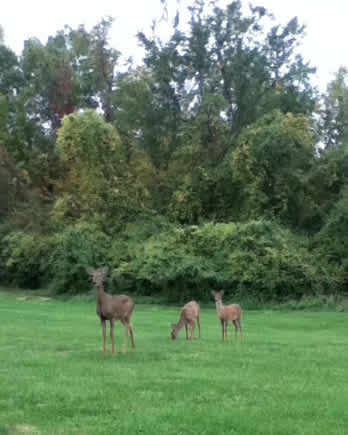Bowhunting the October Lull
In Search of Whitetails 10.02.12

This spring and summer, we had the joy of watching a doe living mostly in our backyard. Deer sightings are common in our neighborhood; there’s a creek about a quarter of a mile away where the main herd beds down. But this doe left the herd and spent most of her time eating our hostas (bad) and trimming back the weeds (good). For the most part she avoided the main herd, and one night in late spring we figured out why: she was raising a young fawn. All summer long we’ve been watching them, marveling at how quickly the fawn has grown. Then October hit, and they were both gone.
I had nothing to do with this, no matter how many half-accusatory glances that are thrown my way.
October marks the start of bowhunting season in Illinois, Iowa, Michigan and other states. It’s a magical time for bowhunters who live there to get out into the woods with the element of surprise. After opening day, however, a confluence of factors brings about one of the most challenging parts of the whitetail deer season: the dreaded October lull.
What is the October Lull?
According to popular belief, October marks a period between the end of summer and the start of the pre-rut where many whitetail deer seem to just… disappear. Frequent feeding areas and watering holes are suddenly empty. That nice buck you’ve been patterning in the warm weather pulls a Houdini. All of that pre-season scouting that you’ve done may not seem as valuable as it did a couple of weeks ago.
 In truth, the October lull marks a change in deer behavior driven by climate and biology. Writing in Field & Stream, Dr. Karl Muller argues that buck activity will increase this month. He draws from a study by Dr. Mark Conner at Chesapeake Farms in Maryland, who found that mature bucks moved an average of 1.5 miles per day in late summer, but 2 miles per day in October. So if the amount of deer movement hasn’t changed, it must be the location of their movement.
In truth, the October lull marks a change in deer behavior driven by climate and biology. Writing in Field & Stream, Dr. Karl Muller argues that buck activity will increase this month. He draws from a study by Dr. Mark Conner at Chesapeake Farms in Maryland, who found that mature bucks moved an average of 1.5 miles per day in late summer, but 2 miles per day in October. So if the amount of deer movement hasn’t changed, it must be the location of their movement.
Some of the contributing factors:
- Whitetail use of agricultural foods changes, as crops are harvested and soybean plants turn yellow.
- Persimmons, acorns, and other forms of mast become available in the woods.
Darren Bradley of IMB Monster Bucks believes that deer dietary changes are a major factor in the perceived October lull, and emphasizes that acorns may be the most important food for deer. High in minerals and protein, easy to consume, and readily available, they’re an ideal source of nutrients as whitetails gear up for the rut.
Bowhunting the Pre-rut
In Missouri and much of the Midwest, October is generally considered “pre-rut” – a period between the end of the summer and the beginning of the rut, which peaks in mid-November. I’ve come across some excellent advice for hunting this unique, challenging period in the book 500 Deer Hunting Tips by Bill Vaznis.
- Bedding areas, food sources, and travel routes. This is a theme touched upon by Vaznis and other favorite writers of mine. Before the rut, feeding is the whitetail’s priority. Working out the bedding sites and food sources, and then pinning down travel routes between them (especially funnels) are the ingredients for success.
- Scrapes near bedding areas. The appearance of new scrapes is the hallmark of the pre-rut, but remember that many bucks are still nocturnal. Scrapes near field edges and in open woods are likely made at night, so focus on those in heavy cover near buck bedding areas. And hunt as close to darkness (early morning and late evening) as possible.
- Backtrack rub lines. Use open fields to find rub lines, but follow them back into the woods and seek out a natural funnel (brush line, creek bottom, or steep ridge) to set up your ambush.
- Scrape analysis. A fresh scrape can tell you a lot about the buck that made it. Antler impressions might give you an idea of the rack (the width, number of points, and length of points). If there are no antler impressions, it may have been a young buck. The direction of prints and the “spray” direction of scat may indicate which way the buck was facing. Relative directions to bedding and feeding areas tell you when the buck was there (if facing away from feeding areas, it was probably early morning).
October is Bowhunting’s Time
There are plenty of reasons to get out and hunt in October. Almost a year ago (October 6th), I shot, tracked, and lost a buck while bowhunting. It’s my favorite time to be out in the woods. The bugs aren’t usually as bad. The cooler weather lets you break out your favorite camo, but not frigid enough to require the Hot Hands. There’s still foliage to offer you some cover, but it’s thinning out to help you scout for sign and game. The woods are just beautiful this time of year. And the deer are out there. Go out and get one!

